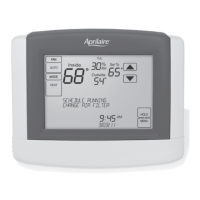Explicit Address Commands are commands sent by the Host controller to a single node at a specific address. Upon receipt of a completed Explicit
Address Command from the Host controller (including the <CR>), each node determines if it is the addressee of the command. If the node is not
the addressee of the command, the command is discarded. If the node is the addressee of the command, it interprets and executes the command
and then prepares a response for the Host controller (depending on the command response control setting C1 – C19).
The command response (if required by the command response control setting) is transmitted by the node during the Solicited Response Sub-slot of
the slot. Since the communication timing and control variables are reset upon receipt of the <CR> from the Host controller, Slot 1 and the Solicited
Response Sub-slot are the currently active slot and sub-slot. As such, if the explicit address command was for node 1, the node may begin
transmitting the response immediately after the command is received. The entire response must be transmitted within the Solicited Response
Sub-slot of the slot. (Maximum bytes per response: 62 = 65ms * 10 / 9600.)
EXPLICIT ADDRESS COMMAND RESPONSE
Global Address Commands are commands sent by the Host controller to all thermostats. Upon receipt of a completed Global Address Command
from the Host controller (including the <CR>), each node determines that the command is a global command. Each node interprets and executes
the command and then prepares a response for the Host controller (depending on the command response control setting C1 – C19).
The command response (if required by the command response control setting) is transmitted by the node during the Solicited Response Sub-slot
of Slot n, where n is the node address. Since the communication timing and control variables are reset upon receipt of the <CR> from the
Host controller, each node must wait for its respective slot before transmitting its response. The slot time from the reset caused by the <CR>
synchronization can be calculated using the following equation:
t = (n–1) x (slot width)
Where n is the node address and slot width is the duration of a slot based on the baud rate.
The node may begin transmitting the response once the communication timer matches the calculated time t, which corresponds to the start of
the Solicited Message Sub-slot of its respective slot. The entire response must be transmitted within the Solicited Response Sub-slot.
(Maximum bytes per response: 62 = 65ms * 10 / 9600.)
GLOBAL ADDRESS COMMAND RESPONSE
Unsolicited Messages are messages sent by the node to the Host controller when a Change-of-State (COS) is detected. Change of State
responses are sent by the node so that the Host controller need not poll each node to determine if any node control variable change has
occurred.
An Unsolicited Message is transmitted by the node during the Unsolicited Response Sub-slot of Slot n, where n is the node address. Slot timing
is synchronized upon a previous receipt of a <CR>. Each node must wait for its respective slot and sub-slot before transmitting its response. The
transmit time from the last synchronization or Communication Frame restart (start of Slot 1) can be calculated using the following equation:
t = (n–1) x (slot width) + (sub-slot width)
Where n is the node address and slot width and sub-slot width are the durations of a slot and sub-slot, respectively, based on the baud rate.
The node may begin transmitting the message once the communication timer matches the calculated time t, which corresponds to the start
of the Unsolicited Message Sub-slot of its respective slot. The entire response must be transmitted within the Unsolicited Response Sub-slot.
(Maximum bytes per response: 62 = 65ms * 10 / 9600.)
UNSOLICITED MESSAGE
4

